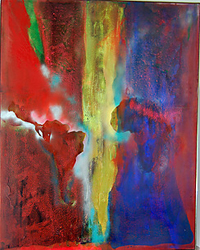FRANK Bowling’s location in London among contemporary British artists while pursuing his memorial and intuitive painting since the late 1960s, classifies him as a ‘British artist’ only in the sense of peer involvement; not on a stronger, more conceptual basis to art-making, provided by his umbilical and influential relationship to Guyana.
 His creative use of conceptual ideas like architectural and atlas shapes and titles referring to Guyana, South America, and Africa in several paintings, though a technique shared by a few important artists in both Britain and the USA during the 1960s, proved Bowling’s personal interest in the topic of a human cultural identity, shaped by the relationship between differing races, individuals, countries, continents, and cultures that was initially his Guyanese multi-cultural birthright.
His creative use of conceptual ideas like architectural and atlas shapes and titles referring to Guyana, South America, and Africa in several paintings, though a technique shared by a few important artists in both Britain and the USA during the 1960s, proved Bowling’s personal interest in the topic of a human cultural identity, shaped by the relationship between differing races, individuals, countries, continents, and cultures that was initially his Guyanese multi-cultural birthright.
Unique paintings like ‘South America Squared’, and ‘False Start’ of 1967, or ‘Bartica Born 1 and 3’, of 1968, introduced the topic of Bowling’s relationship to Africa and South America by inserting small atlas shapes of such locations within cool, monochromatic abstract backgrounds.
No other painter of Guyanese origin in the 1960s tackled the overall condition of both colonial transferrals and modern transience. These Bowling paintings, by being so intellectually subtle and conceptually advanced, meant that he could expect only open-minded educated and critical minds to understand the existential value of what he was painting.
Ethnic or national identity
Whereas the topic of anyone’s ethnic/cultural ancestry or inheritance, in art may easily or simply be presented, regardless of the labour of one’s technique (because the artist mostly relies on the real outward appearance of persons and familiar cultural styles), the topic of a national identity in multi-cultural nations is both more conceptually complex, yet socially unproblematic, since it may rely on a non-secular approach, representing the collective cultural inheritance of an entire nation.
Bowling’s success in reaching an overall understanding of Guyanese identity, via his increasingly abstract paintings, was achieved by emphasizing the whole continental and cosmic scope of Guyana’s human and geographical inheritance, rather than his country’s legacy of divisive colonial, historical, ethnic and cultural fragmentation.
‘Night Journey’ The painter’s road to a resolved universal value, via particular visual stimuli from Guyana, meant that viewers of such paintings could find nothing other than an equal experience of human participation.
The painter’s road to a resolved universal value, via particular visual stimuli from Guyana, meant that viewers of such paintings could find nothing other than an equal experience of human participation.
One of Bowling’s outstanding examples of such experience is ‘Night Journey’, a large acrylic painting of 1968, in which two small continental shapes of South America and Africa, almost invisibly submerged in a lush, atmospheric/cosmic background and geometric doorway, are evocative of the African slave’s passage from one continent to another, becoming a journey into unknown, existential ‘darkness’, quite applicable to the entire exploratory and historical settlement of the Americas, from pre-Columbian native times, to later European and colonial immigration.
The painting is, perhaps, a perfect example of a particular race’s historical experience, explored as the ultimate human experience of a terrestrial/cosmic nature.
Abstract universality
Seventy-eight year-old Bowling’s rise from a ‘country boy’ to being the most internationally celebrated and successful abstract painter of Guyanese origin since the 1960s, rests on his progressive use of paint-on-canvas to create beautiful objects, the universal human value of which overrides any subjective ethnic priority.
This is the ultimate goal of a Guyanese identity, which acknowledges its roots in a rich cosmopolitan national history, whose collective cultural deposits find one formal voice in the artist’s paintings.
The acceptance of Bowling’s works in the leading collections of art museums across North America, where he mostly resides today, including The Museum of Modern Art in New York, proves his relevance to the modern world in which the Guyanese identity participates, or contributes, by way of its complete historical and cultural foundation.
Whether Bowling’s canvasses reflect his relationship to all sorts of friends and places far from Guyana, the persistence, up to the present, of countless stunning paintings with titles like ‘Towards Crab Island’ (1982), ‘Barticaflats’ (1986), ‘Sacha Jason Guyana Dreams’ (1989), ‘Kitty’ (2009), or ‘Old Dutch Vase’ (2010) show his identity, often subconsciously rooted in a Guyanese experience.
Influences/similarities
However, Bowling’s techniques may seem to reflect great 19th Century English painters like Turner and Constable; we can also tag the abstraction of his impasto technique closer to a renowned 20th Century abstract painter like Tunisia-born Italian painter, Antonio Corpora; or Armando Reveron, the magnificent coastal 20th Century bohemian Venezuelan painter, who made monochromatic South American paintings before anyone else, and who also knew Turner’s paintings.
Many of Bowling’s paintings are quite comparable to Reveron’s, as they are to Turner’s, for the simple reason that Reveron had already reflected the great English painter’s spatial monochromatic lessons before Bowling did.
When all is said and done, looking at Bowling’s paintings of today, we see reflected the theme of the universal in the particular, and vice versa, via a disarmingly valuable creative temperament, which often boldly asserts the stark, rugged, organic beauty of Guyana as a significant landscape whose contemplation and appreciation contained in his aesthetic vision reflects an inspiring and progressive open-minded Guyanese identity.





.jpg)








